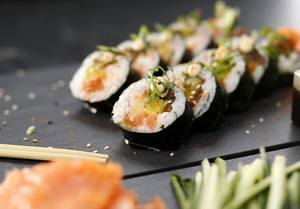
Move over fashion designers. When it comes to hot trends, what you eat is making more headlines than what you wear.
Over the last several years, we have seen kale become as famous as the Kardashians, and gluten-free foods having a cult following beyond Hollywood. Sriracha sauce is the new ketchup, avocado toasts are a morning must, and cauliflower has become the king of white foods. Whole wheat flour is yesterday’s news as chickpea flour is making its way into the shopping carts of Americans.
So which foods will be the hottest trends in 2018? My money is on figs. They can be a savory afternoon snack, tossed in salads, or grilled on skewers as a sweet dessert. Figs are packed with fiber and iron and provide a smidgen of calcium to boot. Because Americans are trying to cut back on the added sugars in their diets, we need to find a natural way to satisfy our voracious desire for sweets. One bite into a fig, and you will immediately know that Mother Nature has answered our sweet tooth prayers.
Here are other 2018 food trend predictions from my nutrition colleagues:
Collagen-Rich Bone Broth
“The next superfood isn’t green. Collagen has moved over from the cosmetics aisle and become the trendiest new superfood. Collagen is the most abundant protein in our bodies and found in muscles, bones, skin, and tendons. Our body’s collagen production naturally begins to slow down as we age. A boost in collagen has shown to improve the health of skin, strengthen nails, hair and teeth. You can buy powders to add to your morning smoothies, coffee, or consume bone broth instead of stock.”
Kate Wilson McGowan, RDN of Brooklyn, NY
Jackfruit
“It’s one of the world’s largest fruits that’s popular in some parts of Asia and Africa, but generally unknown to most Americans. With the texture of chicken or pulled pork the green (unripe) varieties of jackfruit have a mild taste that readily absorbs flavors from the spices and sauces it is cooked with. From tacos, curries and “meatballs” to soups and salads, jackfruit’s versatility will make it a popular ingredient in both plant based and meat containing diets. While it does not contain as much protein as other meat alternatives, jackfruit is low in fat and sodium but high in magnesium and potassium, two nutrients that help regulate blood pressure but are generally lacking in the standard American diet. Jackfruit also contains some fiber, vitamin B6 and vitamin C.”
Cordialis Msora-Kasago, MA, RD, Founder of The African Pot Nutrition and Media Spokesperson for the Academy of Nutrition and Dietetics
Broccoli Rabe
“This vegetable has shown up on a few menus, and while it’s not abundant in all areas of the country’s supermarkets, I think it’s time has come to go mainstream. It’s actually related to the turnip family and is popular in Italian cuisine (I grew up eating it!). Broccoli rabe is very simple to prepare and loaded with fiber, vitamins A and C and potassium and tastier than kale!”
Rosanne Rust, coauthor of DASH Diet For Dummies®
Seaweed
“Many Americans have been enjoying seaweed as a salad or a wrapping for their sushi, but seaweed is now emerging as an addition to crackers and smoothies as well as being infused into pasta. This sea vegetable is a natural source of numerous vitamins and minerals including vitamin C, vitamin K, folate, calcium, iron, and iodine. Most types of seaweed contain omega-3 fatty acids, which may offer anti-inflammatory benefits and improve heart health. The only caveat is excessive consumption of iodine can be harmful so watching your portions of this sea vegetable is important.”
Kristen Smith, MS, RDN, Media Spokesperson for the Academy of Nutrition and Dietetics and Creator of 360 Family Nutrition
Prebiotics
“A prebiotic is a plant fiber that is food for the good bacteria that lives in our colon. Without them, the good bacteria also known as probiotics cannot flourish. Probiotics may improve digestion, boost immunity and possibly even help with weight control. Good sources of prebiotics include: onions, spinach, oats, Jerusalem artichokes, garlic, whole grains, asparagus and apples.”
Keri Gans, registered dietitian nutritionist, author, The Small Change Diet
Grain-Free Everything
“I’m seeing more and more products on the store shelves catering to grain-free diets, such as grain-free granolas, grain-free cookies, and cauliflower pizza crusts. These items tend to contain plant-based fats such as nuts, seeds, and avocados, and may help you sneak in an extra serving of veggies.”
Melissa Groves, RDN, Retail Dietitian for Hannaford Markets and Owner of Avocado Grove Nutrition & Wellness
Resistant Starch
“With gut health garnering a lot of attention in the media and by health care professionals, I think resistant starch will rise to become a trendy ingredient. Resistant starch is a prebiotic that acts similar to fiber to feed the good bacteria in our gut. This type of starch can help to improve blood sugar levels and control appetite possibly leading to weight loss. Resistant starch is created by cooking and then cooling foods like rice or potatoes before you consume them. It’s also found in green bananas so expect to see more products on the shelves with green banana flour. “
Lauren Harris-Pincus, MS, RDN, author of The Protein-Packed Breakfast Club
Cardamon
“Cardamom is an underutilized spice from India that will be showing up in more recipes and on restaurant menus in 2018. Cardamom provides a pungent sweet flavor to foods and you’ll be seeing it in baked goods, oatmeal, pancakes, yogurt, and almond milk. It’s especially delicious in warm drinks such as mulled wine and apple cider. Cardamon contains a compound called cineole, which has antibacterial effects. Similar to ginger, current cell and animal research suggests that cardamom can boost the immune system and enhance the activity of natural killer cells, which aid in the destruction of cancer cells.”
Christy Brissette, MS, RD, President of 80 Twenty Nutrition
This article originally appeared on the US News & World Report website.